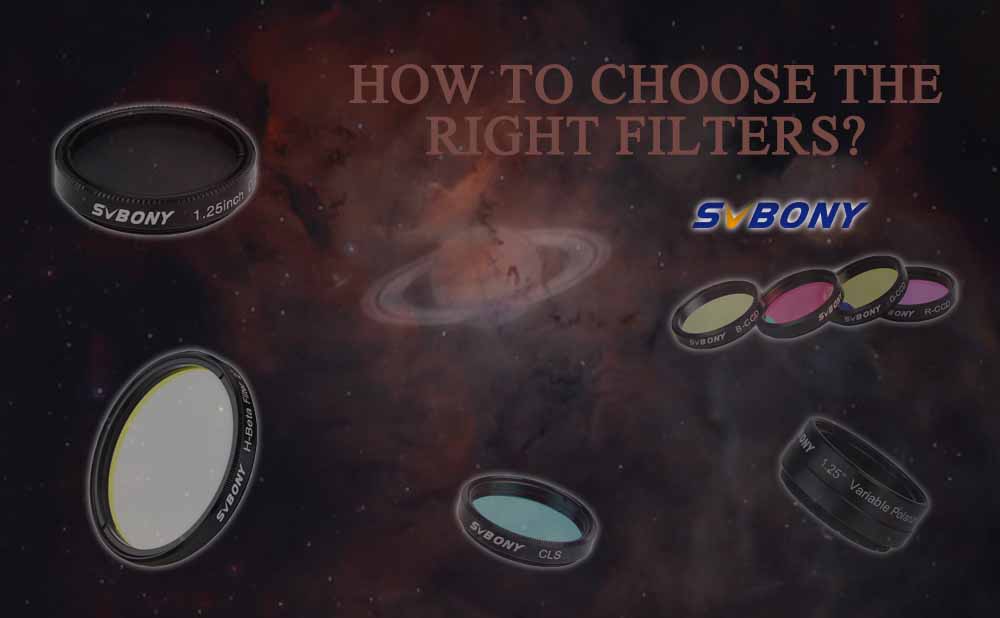Learn How to Pick the Right Filter for Yourself

Learn How to Pick the Right Filter for Yourself
There are several types of astronomical filters used in astronomy and astrophotography. Here are some commonly used ones:
Light Pollution Filters
These filters are designed to reduce the impact of light pollution from artificial sources like streetlights and cities. They selectively block certain wavelengths associated with light pollution, allowing for better visibility of faint objects and increased contrast.
Narrowband Filters
Narrowband filters allow specific emission lines from nebulae to pass through while blocking other wavelengths. They are often used to isolate the light emitted by hydrogen (H-alpha), oxygen, sulfur, and other elements present in nebulae. These filters are particularly useful for capturing detailed images of emission nebulae.
Broadband Filters
Broadband filters, such as LRGB (Luminance, Red, Green, Blue) filters, mimic the response of the human eye and capture a broad range of wavelengths. They are commonly used for capturing color images of celestial objects, including galaxies, star clusters, and planetary nebulae.
UV/IR Cut Filters
Ultraviolet (UV) and Infrared (IR) cut filters block UV and IR light from reaching the imaging sensor or film. These filters help improve color accuracy and prevent unwanted effects caused by UV and IR light, such as fringing or color shifts.
Solar Filters
Solar filters are specifically designed for safe observation of the Sun. They block a significant amount of light and harmful solar radiation, allowing safe viewing or imaging of solar features, such as sunspots and solar prominences.
Polarizing Filters
Polarizing filters can be used for both terrestrial and astronomical purposes. They help reduce glare and increase contrast by selectively blocking light waves that vibrate in specific orientations. In astronomy, polarizing filters are often used to enhance the visibility of planets or to reduce the brightness of the Moon for better lunar observations.
Comet Filters
These filters are designed to enhance the visibility of comets by suppressing unwanted light and increasing contrast. They can help bring out details like the ion or dust tails of comets.
As a small accessory in astrophotography, it can play a big role in imaging. With so many types of filters, how do you choose the right one for you? Perhaps you can consider the following factors when choosing.
Light Pollution
Light pollution filters help reduce the effects of artificial light sources, such as streetlights or urban areas, on your astrophotography. Look for filters specifically designed to target the wavelengths emitted by common light pollution sources, such as sodium or mercury vapor lamps. These filters can help enhance the visibility of nebulae, galaxies, and other deep-sky objects.
Target Objects
Consider the specific objects you want to capture in your astrophotography. Certain filters can enhance the visibility of particular emission lines or features. For example, narrowband filters like H-alpha filters can boost the visibility of nebulae, while oxygen or sulfur filters can highlight specific emission lines.
Camera or Telescope Compatibility
Ensure that the filter you choose is compatible with your camera or telescope system. Check the specifications and thread sizes to ensure a proper fit. Some filters may require additional adapters for compatibility, so double-check compatibility before purchasing.
Filter Transmission Curve
Pay attention to the transmission curve or spectral response of the filter. This curve shows which wavelengths the filter allows to pass through and how efficiently it does so. Filters with sharp cutoffs and high transmission in desired bands can provide better image contrast and reduce unwanted light.
Budget and Quality
Consider your budget and balance it with the quality of the filter. High-quality filters, often made with multiple layers of coatings, can minimize reflections, ghosting, and color shifts. While they may be more expensive, they can produce better results and last longer.
Of course, the most important thing may be to accumulate experience in trials and comparisons. Maybe you can choose our filter as a start.
Get started now, go to the filter section:https://www.svbony.com/categories/filters/









Guest
I purchased SVBONY telescope filters numbers 12, 21, 23, 56, 82A CP & MOON You're info does not cover the individual colour filters you sell, Why not?
Author
Thank you for getting in touch, sorry for this inconvenience as we just listed some of the filters, maybe we will update next time.